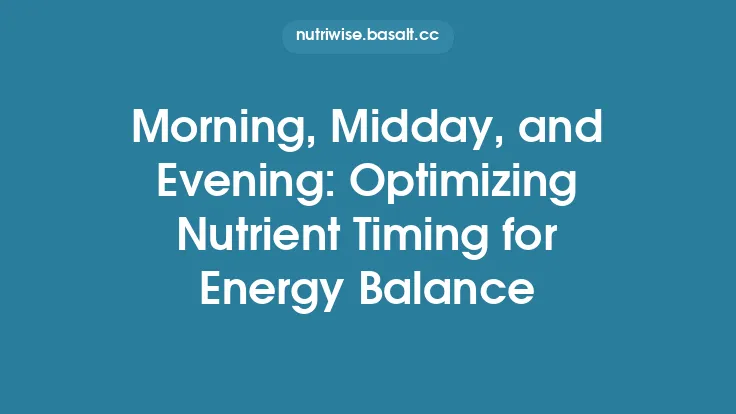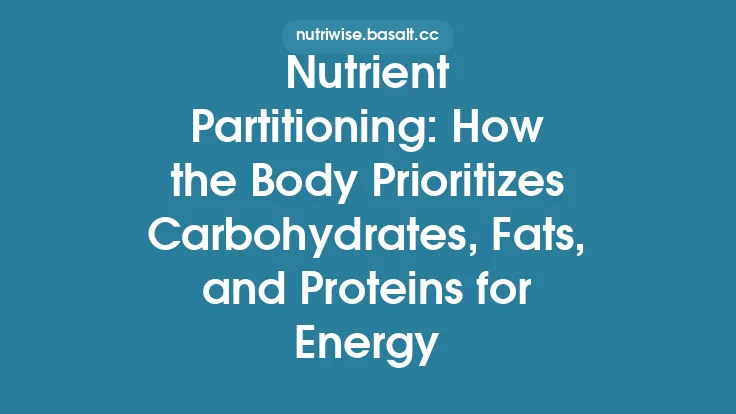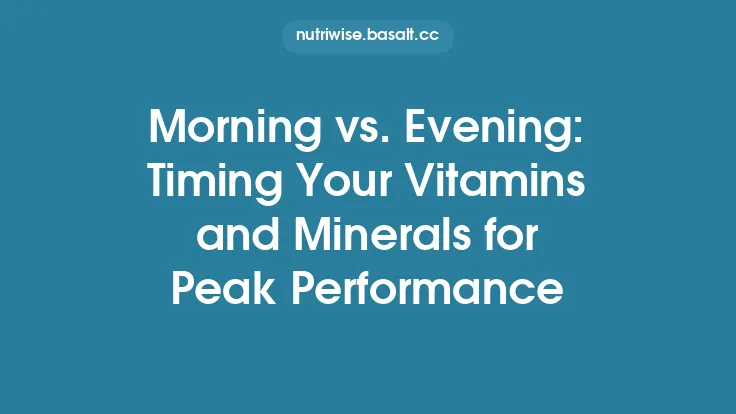Carbohydrates are the body’s primary fuel for the brain and working muscles, yet the timing of when you consume them can dramatically influence how steady your blood‑sugar levels remain throughout the day and how long your energy lasts. By aligning carbohydrate intake with the body’s natural metabolic rhythms, you can avoid the peaks and crashes that often lead to fatigue, cravings, and impaired performance. Below is a comprehensive guide that walks you through the science, practical strategies, and common pitfalls associated with timing carbohydrates for stable glucose and sustained energy.
Understanding Blood Glucose Dynamics
When you eat a carbohydrate‑rich food, enzymes in the digestive tract break down complex sugars into glucose, which then enters the bloodstream. The pancreas responds by releasing insulin, a hormone that facilitates glucose uptake into cells for immediate use or storage as glycogen in the liver and muscles.
Key concepts to grasp:
| Term | What It Means | Relevance to Timing |
|---|---|---|
| Post‑prandial glucose peak | The highest blood‑sugar level reached after a meal, typically 30–90 minutes after eating. | Aiming for a modest, gradual rise helps prevent sharp spikes. |
| Glycemic response curve | The shape of blood‑sugar change over time after a meal. | A flatter curve indicates more stable energy. |
| Insulin sensitivity | How effectively cells respond to insulin. Higher sensitivity = more efficient glucose uptake. | Timing carbs when sensitivity is highest (e.g., after light activity) improves utilization. |
| Hepatic glucose output | The liver’s production of glucose during fasting periods. | Proper carb timing can reduce unnecessary hepatic glucose release, stabilizing fasting glucose. |
Understanding these dynamics allows you to schedule carbohydrate intake so that insulin release is smooth, glucose is efficiently used, and the risk of hypoglycemia or hyperglycemia is minimized.
Glycemic Index and Load: Tools for Carbohydrate Selection
Two complementary metrics help predict how a carbohydrate will affect blood sugar:
- Glycemic Index (GI) – ranks foods on a 0‑100 scale based on how quickly they raise blood glucose relative to pure glucose. Low‑GI foods (≤55) cause slower, more gradual rises; high‑GI foods (>70) provoke rapid spikes.
- Glycemic Load (GL) – multiplies GI by the amount of carbohydrate in a typical serving, providing a more realistic picture of the overall glycemic impact.
Practical application:
- Low‑GI, moderate‑GL foods (e.g., steel‑cut oats, lentils, most fruits) are ideal for breakfast and mid‑day meals when you need sustained energy.
- Higher‑GI, low‑GL foods (e.g., white rice, ripe bananas) can be strategically placed around brief, high‑intensity activities where rapid glucose availability is beneficial.
Meal Composition and Carbohydrate Timing
Carbohydrates do not act in isolation. Pairing them with protein, healthy fats, and fiber modulates the glycemic response:
- Protein slows gastric emptying, flattening the glucose curve.
- Fat further delays carbohydrate absorption, extending the release of glucose.
- Soluble fiber forms a gel in the gut, reducing the rate at which glucose reaches the bloodstream.
Guideline: Aim for a macronutrient ratio of roughly 40‑50 % carbs, 20‑30 % protein, and 30‑35 % fat per main meal. Adjust the exact percentages based on personal tolerance, activity level, and metabolic health.
Pre‑Meal Carbohydrate Strategies for Energy Stability
1. Low‑GI Breakfast for Morning Focus
- Why: Cortisol peaks early in the morning, naturally raising blood glucose. Adding a low‑GI carb prevents an excessive spike while providing a steady supply of glucose for the brain.
- Example: ½ cup cooked steel‑cut oats (GI ≈ 55) topped with a handful of berries, a tablespoon of chia seeds, and a dollop of Greek yogurt.
2. Mid‑Morning “Fuel‑Boost” Snack
- Why: A small, balanced snack 2‑3 hours after breakfast can keep glucose from dipping, especially if you have a long commute or a mentally demanding task.
- Example: An apple (moderate GI) with 1 oz of almonds (fat + protein) – the fat and protein blunt the apple’s glycemic impact.
Post‑Meal Carbohydrate Management
1. Post‑Lunch Glycemic Smoothing
- Timing: Aim to finish lunch within a 30‑minute window and avoid high‑GI desserts immediately after.
- Strategy: Include a source of soluble fiber (e.g., a side salad with vinaigrette) and a modest amount of protein (e.g., grilled chicken). This combination reduces the post‑prandial glucose peak and prolongs satiety.
2. Evening Carbohydrate Considerations
- While the focus of this article is on stable energy, it’s worth noting that a modest, low‑GI carbohydrate portion (e.g., quinoa or sweet potato) paired with lean protein can support overnight glycogen replenishment without causing a disruptive glucose surge that interferes with sleep.
Carbohydrate Timing Around Physical Activity
Pre‑Exercise (30‑60 minutes before):
- Choose a moderate‑GI carbohydrate (e.g., a banana, a slice of whole‑grain toast with honey) to provide readily available glucose without causing a rapid insulin spike that could lower blood sugar during the workout.
During Exercise (lasting >60 minutes):
- Small amounts of high‑GI carbs (e.g., sports drinks, gels) can maintain blood glucose when glycogen stores are depleting. The rapid absorption matches the heightened glucose demand.
Post‑Exercise (within 30 minutes):
- A carbohydrate‑protein blend (e.g., chocolate milk, a smoothie with fruit and whey) accelerates glycogen resynthesis and supports muscle recovery. The protein component also moderates the glycemic response.
Snack Timing and Glycemic Control
Strategic snacking can be a powerful tool for maintaining stable glucose:
| Snack Timing | Ideal Carb Profile | Example |
|---|---|---|
| Mid‑morning (≈10 am) | Low‑GI + fiber | Whole‑grain crackers with hummus |
| Afternoon slump (≈3 pm) | Moderate‑GI + protein | Greek yogurt with a drizzle of honey |
| Pre‑bed (≈9 pm, if needed) | Very low‑GI | A small serving of cottage cheese with sliced cucumber |
The goal is to keep the glycemic curve gently sloping rather than allowing it to dip sharply between meals.
Chronobiology and Carbohydrate Metabolism
Research shows that insulin sensitivity follows a circadian rhythm, typically highest in the morning and gradually declining throughout the day. This means:
- Morning: The body can handle larger carbohydrate loads with less risk of hyperglycemia.
- Evening: Smaller, lower‑GI carbohydrate portions are advisable to avoid excessive insulin demand when sensitivity wanes.
Aligning carb timing with this natural rhythm enhances glucose handling and reduces the likelihood of late‑night spikes that can disrupt sleep and metabolic health.
Practical Meal Planning Templates
Below are three sample day plans that illustrate how to distribute carbohydrates for stable blood sugar. Adjust portion sizes based on individual caloric needs.
Template A – Office Worker (Sedentary to Lightly Active)
| Time | Meal | Carbohydrate Source | Approx. GI | Additional Macros |
|---|---|---|---|---|
| 7:30 am | Breakfast | ½ cup steel‑cut oats + berries | 55 | 1 egg, 1 tbsp almond butter |
| 10:30 am | Snack | Apple + 10 almonds | 40 | – |
| 12:30 pm | Lunch | Quinoa salad with chickpeas, mixed veg, olive oil | 53 | Grilled salmon |
| 3:30 pm | Snack | Greek yogurt + drizzle honey | 45 | – |
| 6:30 pm | Dinner | Baked sweet potato (½ cup) + roasted chicken + broccoli | 44 | – |
| 9:00 pm | Optional Light Snack | Cottage cheese + cucumber | 30 | – |
Template B – Active Individual (Gym 5 × week)
| Time | Meal | Carbohydrate Source | Approx. GI | Additional Macros |
|---|---|---|---|---|
| 6:30 am | Pre‑workout snack | Banana | 55 | 1 tbsp peanut butter |
| 8:00 am | Post‑workout breakfast | Chocolate milk (1 cup) + whole‑grain toast | 70 (milk) / 55 (toast) | Whey protein scoop |
| 11:00 am | Snack | Rice cakes + avocado | 70 | – |
| 1:30 pm | Lunch | Brown rice (1 cup) + turkey breast + mixed greens | 55 | Olive oil dressing |
| 4:00 pm | Pre‑workout snack | Small orange + handful of walnuts | 45 | – |
| 5:30 pm | Post‑workout recovery | Smoothie (berries, banana, whey) | 60 | Greek yogurt |
| 8:00 pm | Dinner | Lentil stew + side of roasted carrots | 45 | – |
Template C – Shift Worker (Irregular Hours)
| Time | Meal | Carbohydrate Source | Approx. GI | Additional Macros |
|---|---|---|---|---|
| 2:00 pm | Breakfast (first meal) | Whole‑grain English muffin + avocado | 55 | 2 boiled eggs |
| 5:00 pm | Snack | Pear + 1 oz cheese | 38 | – |
| 8:00 pm | Main Meal | Barley pilaf with tofu and veggies | 45 | Sesame oil |
| 11:00 pm | Light Snack | Small bowl of mixed berries | 40 | – |
| 2:00 am | Pre‑sleep snack (if needed) | Warm milk (low‑fat) + cinnamon | 30 | – |
These templates illustrate how to pair carbohydrate type, portion, and timing with activity level and circadian considerations.
Common Pitfalls and How to Avoid Them
| Pitfall | Why It Happens | Solution |
|---|---|---|
| Relying on “quick carbs” for every snack | Habitual convenience foods (e.g., candy bars) are high‑GI and cause spikes. | Replace with low‑ or moderate‑GI options that include protein/fiber. |
| Skipping carbs after intense exercise | Misconception that carbs are “bad” for weight loss. | Include a modest carb‑protein blend within 30 minutes post‑exercise to replenish glycogen efficiently. |
| Eating large carb loads late at night | Evening insulin sensitivity is lower, leading to prolonged hyperglycemia. | Keep dinner carbs modest and choose low‑GI sources; consider a small protein‑fat snack if needed. |
| Not accounting for hidden sugars | Processed sauces, flavored yogurts, and beverages can add unexpected carbs. | Read nutrition labels; aim for ≤5 g added sugar per serving. |
| Ignoring individual variability | Genetics, gut microbiome, and health status affect glycemic response. | Use a continuous glucose monitor (CGM) or regular finger‑stick testing to personalize timing. |
Monitoring and Adjusting Your Approach
- Baseline Assessment
- Fast for 8‑12 hours, then measure fasting glucose.
- Record typical meals and note any symptoms of low or high blood sugar (e.g., fatigue, shakiness, cravings).
- Trial Period (2‑4 weeks)
- Implement a structured carb timing plan (e.g., low‑GI breakfast, balanced lunch, moderate‑GI pre‑exercise snack).
- Track energy levels, mood, and any glucose readings if you have a meter.
- Data Review
- Identify patterns: Do you feel a dip 2 hours after lunch? Is there a spike after a particular snack?
- Iterative Tweaks
- Adjust carbohydrate type (swap high‑GI for lower‑GI).
- Modify timing (move a snack earlier or later).
- Add or reduce protein/fat to smooth the curve.
- Long‑Term Maintenance
- Once stable glucose patterns are achieved, maintain the schedule but stay flexible for life events (travel, altered work hours).
- Periodically re‑evaluate, especially after changes in weight, fitness level, or health status.
By understanding how carbohydrates interact with insulin, recognizing the influence of glycemic index and load, and aligning intake with both daily activity and the body’s circadian rhythm, you can craft a carbohydrate timing strategy that keeps blood sugar steady and energy sustained. The result is not only better focus and performance throughout the day but also a foundation for long‑term metabolic health.





